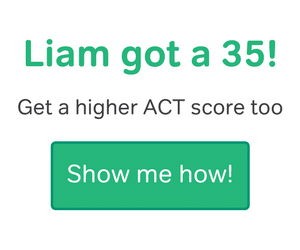


If you’ve come to this post hoping to find the secret ACT tips for the perfect score, I hate to break it to you – but that just doesn’t exist! What I can offer you is the next best thing – tried and true ACT tips and tricks that will maximize your ACT score on test day.
Preparing for success on the ACT starts well before test day. In this post, we’re going to cover how to prepare for the test in advance as well as tips to follow during the test. The ACT tips and tricks we will cover include:
I’ll also provide you with some resources that provide tips tailored for each ACT test section and tips before and during test day to reduce anxiety.
Now, let’s dive right in to some ACT tips for success!
The most effective way to become familiar with the ACT is to include several timed full-length practice tests in your test day preparation process.
Most of us would rather watch paint dry than willingly set aside three-hour blocks of time to take practice tests on a regular basis. But if you’re one of the many students who suffer from test anxiety, exposure to and familiarity with the real deal really does lessen stress. It also allows you to establish a baseline score and see how you’re improving as you progress through your ACT preparation process. To best prepare for test day, make sure you’re taking your practice tests in a test-like environment, such as the library or a room tucked away in the quieter part of your home.
I encourage you to reach out to Magoosh to get access to several ACT preparation tools, including practice tests!
Setting aside a chunk of uninterrupted time for timed practice tests can be a hassle, and some might find it impossible on a regular basis. While I still recommend that you try to take as many full-length practice tests as you can, here’s an alternative (and complimentary) ACT trick.

As you work on practice problems, divide them into sets of ten. It doesn’t matter which section you’re working on, as this technique adapts to your abilities and timing.
We have all been there: you’re stuck between two answer choices, and after careful consideration, you choose “B”. A few seconds later, you think maybe it’s “C”. Now you’re unsure again and you go back and ponder again, spending precious moments seconding guessing your gut reaction. An important ACT Tip is to decide that once you’ve reviewed the question and made your choice, trust your initial reaction. Only change your answer choice if you have time at the end and you find hard evidence that you’ve made a mistake and your answer choice must be changed. Second-guessing yourself takes time away from your progress and can impact your confidence as you move through the test, thereby impacting your overall score. Trust your instincts!
The best way to hone in on your time management skills is to use a comprehensive, reliable ACT prep course and resources and practice, practice, practice! Magoosh has several resources to help you prepare for the ACT and sharpen your time management skills!
I know, I know – it’s easier said than done. But you’ve got to remember that no matter how much preparation you do, test day anxiety can still make you succumb to the pressure, forget your practice, and panic – all of which are not helpful to your overall score. So, one of the most important ways to do well on test day is to take a deep breath and relax.
The nerves will likely never fully “go away”, but the goal should be to minimize your stress and anxiety as much as possible. Here are the (not-so) secret ACT tips to do before test day that will help you relax and minimize stress on test day: I call them the 3 P’s: Plan. Practice. Prepare.
If you adequately plan, practice, and prepare, then you should be able to relax, overcome the jitters that everyone feels, and perform your very best on test day.
The ACT tips and tricks above are only one component of how to maximize your score on test day. There are four different sections on the ACT (five including the optional Writing section), and the ACT is set up in such a way that there are also strategies you can use within each section to help push your scores up on the different ACT tests, as well.
Whether you’re looking for all-around improvement or just need to focus on boosting one sectional score that you struggle with, these tips can help you get there!
I discussed briefly in Tip #6 the importance of relaxing and managing anxiety before and during test day. Here’s a post with more detailed last-minute ACT tips to help with anxiety. The most obvious, but the hardest-to-follow tip: Don’t forget to breathe! As with any kind of test-taking strategy, be sure to practice these first. Some strategies may work better than others for you, and you’ll want to figure that out so you have a plan for test day! Good luck, test takers! Keep your minds sharp, your bodies healthy, relax, and do your best; the scores will inherently follow.
Brittny is a Test Prep Expert at Magoosh with almost a decade of experience in test prep and tutoring. Throughout her tutoring and test prep career, Brittny has helped hundreds of students seeking to improve their scores on the SAT, ACT, GRE, and GMAT reach their goals. Brittny also taught business and healthcare courses at a technical college for seven years and was the recipient of the 2016 Instructor of the Year for the Technical College System of Georgia. Outside of her test prep career, Brittny works in population health in Atlanta, Georgia and runs a non-profit 501(c)3 organization dedicated to mentoring college-aged students. Brittny graduated summa cum laude with her B.S. in Nuclear Medicine with a minor in psychology from Old Dominion University in Norfolk, Virginia and earned her MBA and MHA from Georgia State University. Come join Brittny and the Magoosh team on Youtube, Facebook, and Instagram, or connect with her via LinkedIn! View all posts